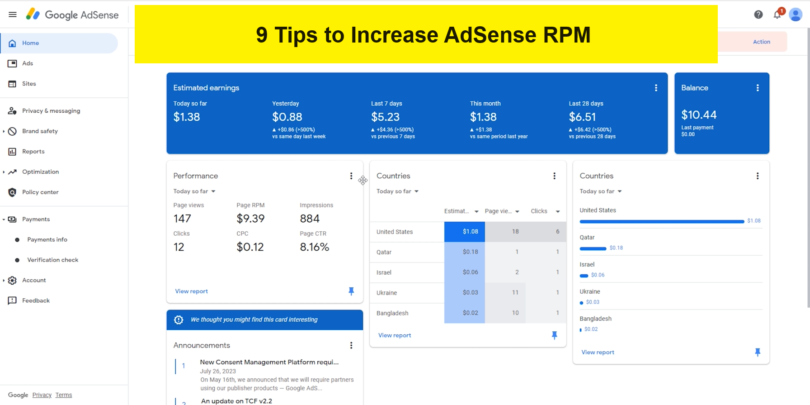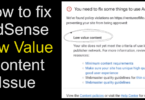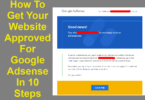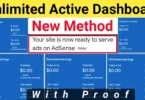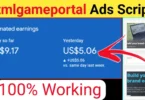Welcome to our guide on supercharging your website’s revenue. Today, we’re diving into the world of Google AdSense and exploring nine crucial tips to increase your AdSense RPM. Whether you’re new to AdSense or looking to boost your current earnings, these strategies are key to your success. AdSense RPM stands for Revenue per Mille; it measures your earnings per thousand ad impressions, in other words, ad views, and determines how effectively your site turns them into earnings. So let’s start.
Tip 1: Optimize Ad Placements
Strategically placing your ads is crucial to significantly boosting your RPM. Key areas for ad placements include the right or left side of the page, as these positions often perform better than middle placements. According to Google AdSense, these ad units are called side rails. Placing ads near the bottom of the screen, right above the fold, has been shown to have the highest viewability rates. Blending ads between content sections can attract your reader’s attention without being disruptive, and placing ads near engaging content like images and videos can further increase the chances of interaction. Here’s an example: position your banner ad within the viewport but not at the very top where it could easily be ignored. This placement is key for visibility.
Tip 2: Focus on High-Paying Keywords
In the world of AdSense RPM, keywords are your anchor. Some keywords are more sought after by advertisers than others due to their high conversion potential, leading to a higher CPC. This can significantly boost your RPM. But how do you find these high-paying keywords? Start with research tools like Google’s Keyword Planner or SEMrush. These tools don’t just offer a list of potential high earners but also provide insights into search volume and competition. Don’t forget about competitor analysis; keep an eye on the keywords your competitors are targeting. You might discover valuable keywords they tapped into that you haven’t explored. Niche topics: broad subjects are highly competitive, but niche areas can reveal both high-paying and less competitive keywords. Once you’ve identified these keywords, the next step is to embed them naturally within your content. Tools like AI text generators can assist in integrating these keywords seamlessly, but remember, the key is natural integration. Keyword stuffing can deter readers and negatively impact RPM.
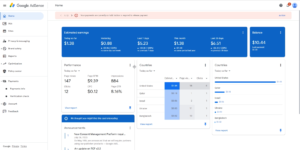
Tip 3: Choose the Right Ad Formats
Ad formats play a crucial role in enhancing user experience and driving revenue. The secret to success is high-performing ads that offer good viewability and engagement without compromising user experience. We recommend monitoring performance metrics such as CTRs and viewability. High CTRs are indications that the ad format or content is beneficial for users. Also, consider non-intrusive designs. Ads like native ads or in-content banners blend seamlessly with content, ensuring a smooth user experience.
Tip 4: Increase Website Traffic
The more visitors you have, the higher your potential for ad engagement. Let’s explore effective strategies to boost your website traffic. Write the content which is helpful and useful for the user. Google rewards content that genuinely enhances user experience. Optimize for Google Discover: appearing in Google Discover can significantly increase your visibility and attract users early in their search journey. But don’t put all your eggs in one basket; diversify your content across different social media platforms to engage a broader audience. Engage in strategic sharing: distribute your content on platforms where your target audience is most active. This drives both direct and referral traffic, enhancing your site’s exposure and boosting your AdSense RPM.
Tip 5: Experiment with Ad Types
To diversify your ad experience, let’s look at some AdSense options every publisher should know. Text and display ads are the traditional types; they appear as banners or sidebars and can be text-based or feature visual graphics. These are versatile and widely used. In-feed ads integrate seamlessly into your content feeds; they blend well with your content, offering a less disruptive user experience. In-article ads are designed specifically for articles and content pages; they’re optimized for readability on both mobile and desktop, fitting smoothly within your content. Overlay and interstitial ads are full-screen and mobile-optimized, providing high visibility. However, it’s important to monitor if they’re affecting user engagement.
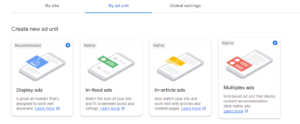
Tip 6: Compatible With Mobile View
The surge in mobile traffic is a game-changer. Statista reports that mobile devices account for over 58% of global website traffic. In this mobile-first world, having a mobile-optimized website is key to boosting your RPM. Firstly, ensure your website has a responsive design; it should adjust seamlessly across various screen sizes. A site that’s perfect on desktop but misaligned on mobile can drive visitors away. Secondly, user friendly site manu which is helpful and easy to use for visitors. Make the user journey intuitive. Thirdly, place ads where they’re most likely to be noticed yet don’t disrupt content consumption. An unseen ad on mobile is a missed revenue opportunity.
Tip 7: Switch to Setupad Prebid AdSense
For AdSense publishers looking to increase ad revenue even more, Setupad Prebid AdSense offers a cutting-edge solution. This innovative product enhances your AdSense earnings by integrating AdSense demand with Setupad’s Prebid demand from over 30 premium SSPs. It operates through a real-time auction system, ensuring the highest bidder wins the ad impression. This competitive setup prompts AdSense to offer higher prices for ad placements, maximizing your ad revenue. The benefits for publishers are substantial. With Setupad Prebid server, you get seamless server-to-server connections, enhancing the efficiency of your ad operations. Plus, Setupad provides comprehensive technical support and header bidding management, all without any additional costs to you, the publisher.
Tip 8: Increase Website Speed
Did you know that if your website takes longer than 4 seconds to load, one in four visitors will leave? Speed matters, and here’s why: a faster website not only offers a better user experience but ensures your ads are seen and interacted with, positively impacting your RPM. So, how can you enhance your site’s loading speed? First, start by compressing images to reduce file sizes without compromising quality. Second, minimize code by eliminating unnecessary characters, white spaces, and comments. Third, use a CDN to distribute your content globally, ensuring fast access for users. Fourth, optimize server response time by choosing a reliable hosting provider and monitoring server performance regularly. Leverage browser caching to let returning visitors load your site faster. Remember, every second saved enhances the user experience, leading to satisfied visitors and potentially higher ad engagement.
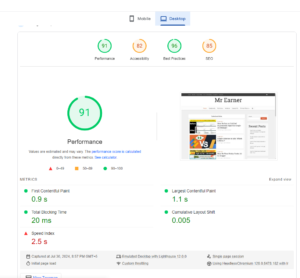
Tip 9: Engage with the Audience
Proactively engage with readers by responding to comments, initiating conversations, and deploying surveys or polls. Consider sending welcome emails to new subscribers, introducing yourself, and sharing your brand story. If you’re short on time, having an AI chatbot on your website can answer their questions, showing that you care about user experience. These interactions not only build trust but also provide valuable insights into what your audience values. Use this knowledge to refine your ad placements and curate content that resonates.
Conclusion
Boosting AdSense RPM isn’t a one-time affair. It demands consistent effort and adaptation to evolving digital trends. We hope these tips help. Bye and see you next time.
